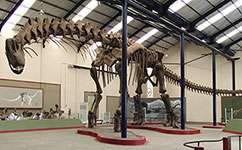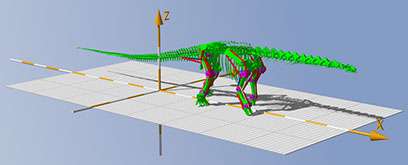Scientists teach largest dinosaurs to walk

For the first time scientists have learnt how the largest four-legged dinosaurs got from A to B.
The new research, published in Plos ONE, explores how one of the biggest animals to have lived on Earth, the Argentinosaurus, walked.
The Argentinosaurs, at 80 tonnes and 40m long was the equivalent of fifteen elephants, and scientists were unsure how such a big animal could even move.
Unlike the T-Rex only part of this dinosaur's skeleton has ever been found, but from the leg and the vertebrae researchers have managed to digitally piece together how the rest of it may have looked.
The team used this digital skeleton to reconstruct the dinosaur's muscles – soft tissue like muscle is almost never found in the fossil record. They then inputted this digital reconstruction of muscle and bone into a supercomputer where, over the course of a week, it learnt to walk.
'Given enough time on a big enough computer the dinosaur model learns to walk, and the nice thing is that all we have to tell the computer is "get from A to B using as little energy as possible" because that seems to be what animals mostly try to do. Then the computer will calculate a locomotive pattern that satisfies it,' says Dr Bill Sellers of the University of Manchester, lead researcher on the project.
Sellers and his team found that the dinosaur walked as expected, but that other activities such as getting up from lying down, or mating, would have been very challenging.

'We think it's right at the limit of what is possible. It's about as big as you can get without drastically changing its body shape,' Sellers says.
While the Argentinosaurus is not the biggest animal ever – blue whales get up to 200 tonnes but they're aquatic, so water supports their weight – it is one of the largest known to have moved on land and Sellers thinks it is possible that ligaments and tendons played a huge role in helping the animal get around.
'What we've done is to create an animal where its soft tissue patterns match modern animals, because that's all we can do. But ligaments, muscles and tendons are not preserved, so they may vary a lot from our assumptions,' Sellers explains. 'We know animals can do clever things with elastic tissue like tendons and ligaments, so it's possible that the right sort of elastic mechanisms might actually improve Argentinosaurus' locomotion considerably. But we have nothing to base that on at the moment.'
Sellers believes it is possible that animals as large as Argentinousaurus had ligaments and tendons similar to those seen in horses.
'Horses have something known as stay mechanisms, a set of tendons and ligaments on limbs that are passive when the animal is just standing there. It means a horse don't have to activate muscles even though its legs aren't straight. That sort of passive elastic support is probable but we may never find evidence for that in the fossil record,' he concludes.
More information: Sellers WI, Margetts L, Coria RA, Manning PL (2013) March of the Titans: The Locomotor Capabilities of Sauropod Dinosaurs. PLoS ONE 8(10): e78733. DOI: 10.1371/journal.pone.0078733
Journal information: PLoS ONE
Provided by PlanetEarth Online
This story is republished courtesy of Planet Earth online, a free, companion website to the award-winning magazine Planet Earth published and funded by the Natural Environment Research Council (NERC).





















